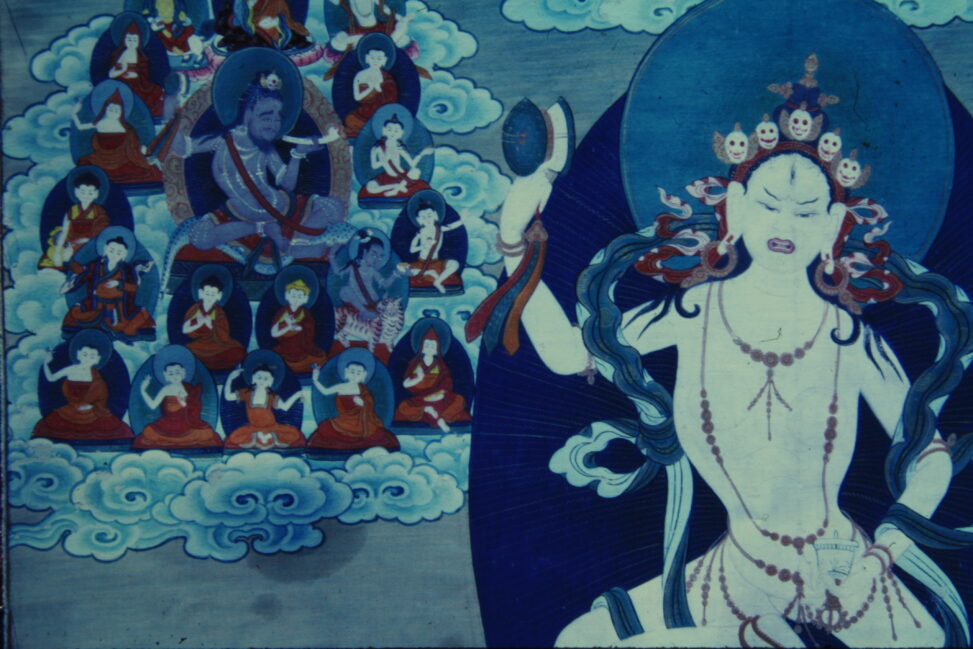Published in The Tibet Society Bulletin, 1975, Volume 9, The Tibet Society, Indiana University. By B Nimri Aziz, with translation assistance by G. Lobsang. ( Reproduced in full by BN Aziz from author’s hardcopy, 2020)
Pha Dampa Sangyas was the son of an Indian Brahmin couple who grew up in that most holy of lands many centuries ago (~1050-1117?). From an early age he showed signs of being exceptional, and was possessed with a conviction that he should travel to Tibet to teach.
His teacher’s permission to do so was granted only on the condition that Pha Dampa promise not perform the siddhi of transferring his mind into another body; this was a practice in which Pha Dampa had mastered. His teacher pledged that if Pha Dampa agreed to kept his vow to follow that edict, he would become a great teacher, renowned across Tibet. Determined to fulfill that mission, he secured his teacher’s blessing and set out for Tibet.
On his way to Tibet however Pha Dampa encountered a dilemma concerning that agreement. His plan would be foiled by another Indian yogi, a jealous figure loath that any yogi other than himself should attain great powers and reputation. This wily fellow was miserable in appearance, old and decrepit; his skins was withered, his face pocked marked, his limbs askew. He was frightening to look at and kept himself hidden to avoid people’s derisive calls. e was determined to undermine Pha Dampa, and followed him to Tibet .
He had learned of the augury and the promise Pha Dampa had made to his teacher and devised a plan to trick Pha Dampa into breaking his vow. With this aim he followed the handsome ascetic to Tibet, hoping for a chance to steal his powers.
Along the route, at a place known as Nepal (probably near Kathmandu Valley) , Pha Dampa came to a village of humble and poor peasants who, he learned were afflicted by a plague sweeping their settlement. Many inhabitants had already died, and others feared that without help all of them would become corpses. Pha Dampa, out of his abundant compassion for those wretched folk, inquired about their problem. The desperate villagers told him that an elephant, dead and decaying, had toppled into the river above the village. Its corpse remained lodged there, they informed the visitor, and they explained how its rotting flesh was contaminating the stream, the village’s only supply of water. If the corpse could be removed, they might be spared, they pleaded.
Pha Dampa decided to investigate and climbing about the village, he followed the course of the stream and soon witnessed that the decaying body of the elephant was indeed defiling the river water. With his heart became heavy with compassion, he decided he must do everything in his power to help alleviate the villagers’ suffering.
As far as he could assess from his own experience and wisdom, there was a way to remove the body of the elephant. But this solution would entail Ph Dampa leaving his own body. He decided to take that course, and thus entered the form of the elephant, whereupon he was able to lift it from its defiling place and set it a safe distance away.
While Pha Dampa was so engaged, the jealous yogi, hiding nearby, saw his chance to undermine his rival. He’d been following Pha Dampa for some days, watching his every move, yet hardly imagining that such an opportunity like this would arise. Stealthily the pockmarked, crippled figure hastily seized Pha Dampa’s body, the one he’d set aside while he was lifting the elephant. He entered it and slipped away in his newly acquired form—graceful and handsome.
After the culprit had run off, Pha Dampa, having achieved his miracle of compassion, returned to the riverbank where he gazed at the withered and reddened body of the jealous yogi laying where he had left his own. Suddenly he realized what had happened. Here was the danger his teacher warned him about: he had unwittingly broken his promise not to exercise the siddhi of mind-transference.
Pha Dampa reviewed the possibilities open to him. He considered the option of not entering the yogi’s old body that lay there before him. He had the power to simply transfer his mind to a state after death and move beyond the sphere of worldly existence.
However, remembering his bodhisattva vow, he reconsidered. Even if he assumed the discarded ugly body, he realized he could still continue his mission to Tibet. So he did this. Thus, taking the form of the old yogi, Pha Dampa became transformed into an old man, as pockmarked and wretched looking as its previous occupant. Even so, his new appearance so embarrassed him that Pha Dampa dared not return to his country and face his teacher.
It was his destiny to continue on to Tibet, he decided and so proceeded north through the mountains and reached the place that would be called Dingri, specifically the solitary hill of Langkor. Pha Dampa remained there, attracting disciples from across Tibet and indeed became a sought-after teacher. His Dingri adventures are recounted in other stories (among them, his “One Hundred Instructions to the People of Dingri”[1]. Pha Dampa died in Dingri Langkor, having never left that place during all this time in Tibet.
Visual depictions of Pha Dampa are often of a man, white-haired and scrawny, very unlike the elegant and hearty yogi one is accustomed to seeing in Buddhist paintings and statues. That form which you see is actually not the original body of Pha Dampa, but the jealous yogi Pha Dampa reluctantly inherited through events recounted in this tale.
[1] 1974 “One Hundred Instructions to the People of Dingri”, translated by June Campbell, Kailash, Journal of Himalayan Studies, 1974 (2;3) This is a well known collection and is also available at https://wahiduddin.net/budh/hundred_verses.htm.

